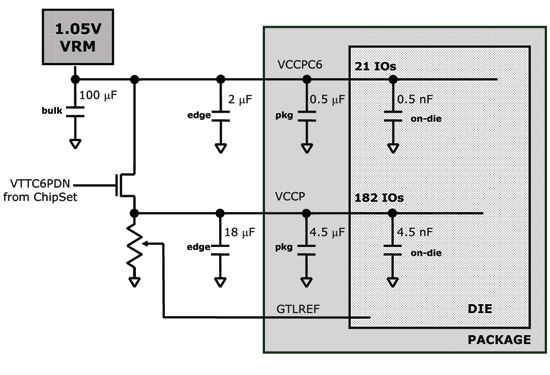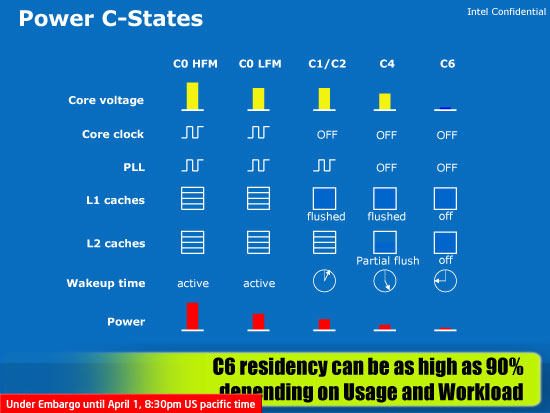Intel's Atom Architecture: The Journey Begins
by Anand Lal Shimpi on April 2, 2008 12:05 AM EST- Posted in
- CPUs
Lower Power than Centrino
(This page is taken from our earlier look at the Intel Atom architecture)
With mobile Penryn Intel introduced a new power state it calls C6. In the C6 power state the CPU is in a virtual reset state, and core voltage is very close to zero. The core clock, all of the PLLs, and caches are completely turned off. All of the state data is saved in a 10.5KB storage area, similar to mobile Penryn (but smaller since there's not as much state to save). Upon exiting C6 the processor's previous state is restored from this memory, called the C6 array. It takes around 100us to get out of C6, but the power savings are more than worth the effort - it's a similar approach of power for performance that we saw in the design of the original Pentium M processor.
Clock gating (sending the clock signal through a logic gate that can disable it on the fly, thus shutting off whatever the clock connects to) is an obvious aspect of Atom's design. All Intel processors use clock gating; Atom simply uses it more aggressively - the clock going to every "power zone" is gated, something that isn't the case in mobile Core 2. Each logic cluster (205 total) in Atom is referred to as a Functional Unit Block (FUB) and the entire chip uses what Intel calls a sea of FUB design. Each FUB is clock gated and can be disabled independently to optimize for power consumption. The cache in Atom is in its own FUB, which apparently isn't the case in mobile Core 2.

Keeping Silverthorne on life support, only 21 pins are necessary
Atom uses a split power plane; in its deepest sleep state (C6) the chip can shut off all but 21 pins which are driven by the 1.05V VRM. By having two separate power planes the chip can manage power on a more granular level. While it can't disable individual pins, it can disable large groups of them leaving only 21 active when things like the L2 cache and bus interface are powered down.

Intel mentioned that Atom will remain in its C6 sleep state 90% of the time. However, that figure is slightly misleading because it's only possible to remain in C6 when the CPU is completely idle. The 90% figure comes from taking into account a mobile device sitting in your pocket doing nothing most of the time. When in use, Atom won't be able to spend nearly that much time in C6.
Despite the implementation of a C6 power state, Atom will still lose to ARM based processors in both active and idle power. The active power disadvantage will be erased over the coming years as the microarchitecture evolves (and smaller manufacturing processes are implemented), while the idle power requires more of a platform approach. As we reported in our first Menlow/Silverthorne article:
"The idle power reduction will come through highly integrated platforms, like what we're describing with Moorestown. By getting rid of the PCI bus and replacing it with Intel's own custom low-power interface, Intel hopes to get idle power under control. The idea is that I/O ports will only be woken up when needed (similar to how the data lines on the Centrino FSB function), and what will result are platforms with multiple days of battery life when playing back music."










46 Comments
View All Comments
FlakeCannon - Wednesday, April 2, 2008 - link
This was an absolutely fantastic article as far as I'm concerned. One of the best I've read from AnandTech. I'm truly impressed with the amount of effort and dedication that the engineers at Intel put into the Atom. Thought the consumer may not see its importance today the Atom will continue to develop one throughout the next 2 years and show why this is such a huge step in the right direction. I really think that this article outlines very well the architecture involved and where it intends to lead Intel and others in the future.I'm always impressed to see Intel take architecture that was revolutionary in its time 15 years ago in the Pentium and Pentium Pro and resurrect it in modern day fashion with help of the Dothan Pentium M architecture and even things borrowed from the miserable Netburst technology that 15 years later I believe will once again create a product revolutionary in nature. I was never able to appreciate it in the days of the Pentium but certainly can now.
This is one product I think is deserving of being excited about.
fitten - Wednesday, April 2, 2008 - link
What does an on-die memory controller have to do with ILP?Anand Lal Shimpi - Wednesday, April 2, 2008 - link
Woops, I've clarified the statement :)Take care,
Anand
erwos - Wednesday, April 2, 2008 - link
I was thinking that this would be a fantastic platform for making a small, silent HTPC box for doing streaming media, but the lack of 1080p output kills that to a large extent. I know it's not a big priority for the first revision given the UMPC targeting, but I hope the "Atom 2" does try to squeeze that feature in.FITCamaro - Wednesday, April 2, 2008 - link
It could always be paired with a different, more capable graphics core.ltcommanderdata - Wednesday, April 2, 2008 - link
It;d be very interesting to see how the 1.86GHz Silverthorne stacks up against a 1.8GHz P4 Northwood, a 1.86GHz Dothan, a 1.8GHz Conroe-L based Celeron, and a 1.8GHz Athlon 64.I wonder if Apple is going to refresh AppleTV with Silverthorne since it seems ideal with replace the current 1GHz ULV Dothan in there.
yyrkoon - Wednesday, April 2, 2008 - link
Well at least Intel did not name their Atom CPUs the 'Atom Z80' . . . heh.Anyways, this is good for our future, as the mITX, and pITX 'systems' now days are still kind of large-ish, and cost quite a bit of money for what they are. Though, I think that putting a web browser on just any old appliance in the house would be way overkill, and possibly a very serious mistake. A TV with a web browser ? An Oven ? Please . . . this is why we have PCs, and micro mobile devices.
Recently a friend and myself have been working on an embedded project, and I can see the potential here, but a 'problem' does exist. Some of the things you would want to do with such a processor . . . well lets just say there still would not be enough processing power. That being said, I do not see why these could not help make a TVs/HD-DVD player menu operate faster.
pugster - Thursday, April 3, 2008 - link
It certainly sounds nice, but the atom processor cost alot because some of the higher end models cost more than $100 each. I find it surprising that their Polosbo chipset is manufactured at 130mm. It probably came from one of their foundries that was due to upgrade to 32mm sometime next year anyways. They could've earily manufactured at 65mm.Somehow I don't see their product as mature and maybe the next gen product they would have a cpu and the north/south bridge in the same die.
lopri - Wednesday, April 2, 2008 - link
I honestly don't get the excitement. Should I? I mean, I wouldn't feel comfortable with one gigantic company controlling every single electronics in our life. If Intel opens up the X86 and everyone can compete on even end, then maybe. Since that won't happen, the future looks scary enough.clnee55 - Wednesday, April 2, 2008 - link
NO, how can you get excitement. I am already bored with your conspiracy theory. Let's talk about tecnical issue here.